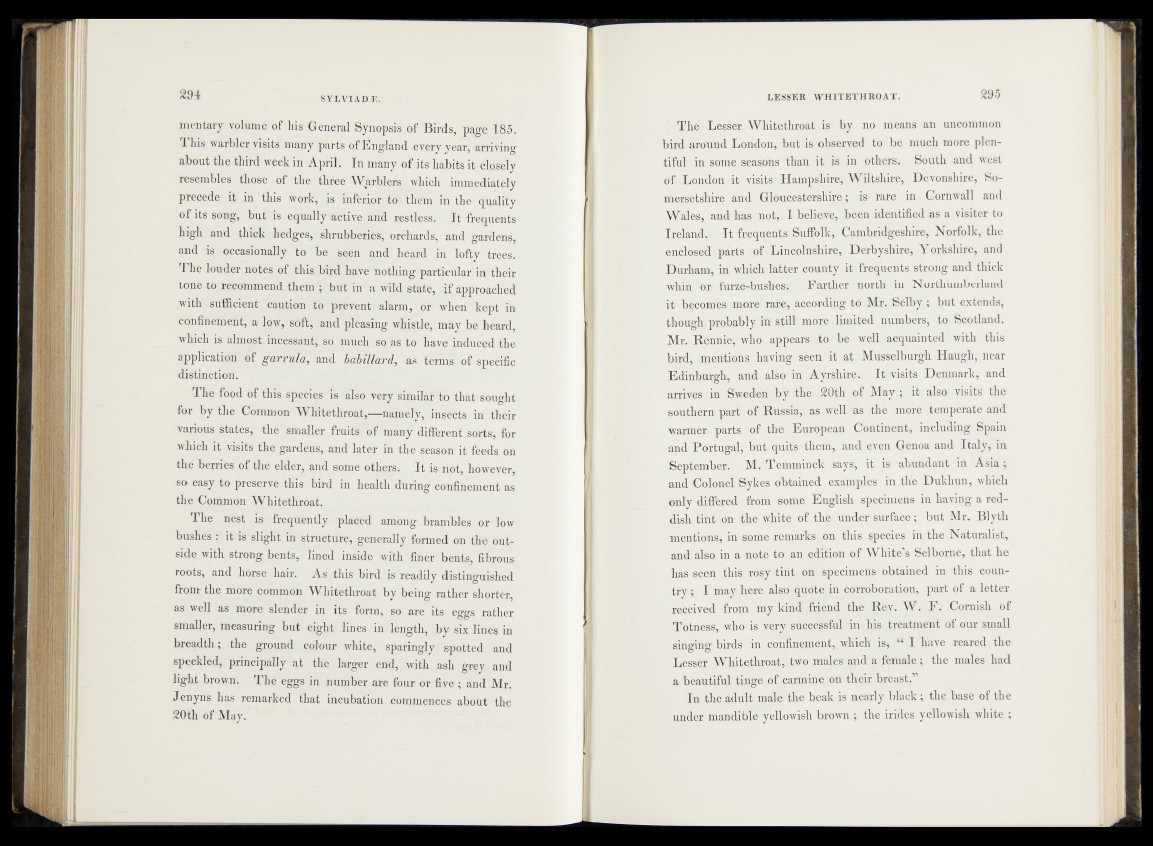
mentary volume of liis General Synopsis of Birds, page 185.
This warbler visits many parts of England every year, arriving
about the third week in April. In many of its habits it closely
resembles those of the three AVar biers which immediately
precede it in this work, is inferior to them in the quality
of its song, but is equally active and restless. It frequents
high and thick hedges, shrubberies, orchards, and gardens,
and is occasionally to be seen and heard in lofty trees.
I he louder notes of this bird have nothing particular in their
tone to recommend them ; but in a wild state, if approached
with sufficient caution to prevent alarm, or when kept in
confinement, a low, soft, and pleasing whistle, may be heard,
which is almost incessant, so much so as to have induced the
application of garrula, and babillard, as terms of specific
distinction.
The food of this species is also very similar to that sought
for by the Common Whitethroat,—namely, insects in their
various states, the smaller fruits of many different sorts, for
which it visits the gardens, and later in the season it feeds on
the berries of the elder, and some others. It is not, however,
so easy to preserve this bird in health during confinement as
the Common Whitethroat.
The nest is frequently placed among brambles or low
bushes : it is slight in structure, generally formed on the outside
with strong bents, lined inside with finer bents, fibrous
roots, and horse hair. As this bird is readily distinguished
from- the more common Whitethroat by being rather shorter,
as well as more slender in its form, so are its eggs rather
smaller, measuring but eight lines in length, by six lines in
breadth; the ground colour white, sparingly spotted and
speckled, principally at the larger end, with ash grey and
light brown. The eggs in number are four or five ; and Mr.
Jenyns has remarked that incubation commences about the
20th of May.
The Lesser Whitethroat is by no means an uncommon
bird around London, but is observed to be much more plentiful
in some seasons than it is in others. South and west
of London it visits Hampshire, Wiltshire, Devonshire, Somersetshire
and Gloucestershire; is rare in Cornwall and
Wales, and has not, I believe, been identified as a visiter to
Ireland. It frequents Suffolk, Cambridgeshire, Norfolk, the
enclosed parts of Lincolnshire, Derbyshire, Yorkshire, and
Durham, in which latter county it frequents strong and thick
whin or furze-bushes. Farther north in Northumberland
it becomes more rare, according to Mr. Selby ; but extends,
though probably in still more limited numbers, to Scotland.
Mr. Rennie, who appears to be well acquainted with this
bird, mentions having seen it at Musselburgh Haugh, near
Edinburgh, and also in Ayrshire. It visits Denmark, and
arrives in Sweden by the 20th of May ; it also visits the
southern part of Russia, as well as the more temperate and
warmer parts of the European Continent, including Spain
and Portugal, but quits them, and even Genoa and Italy, in
September. M. Temminck says, it is abundant in Asia ;
and Colonel Sykes obtained examples in the Dukhun, which
only differed from some English specimens in having a reddish
tint on the white of the under surface; but Mr. Blyth
mentions, in some remarks on this species in the Naturalist,
and also in a note to an edition of White’s Selborne, that he
has seen this rosy tint on specimens obtained in this country
; I may here also quote in corroboration, part of a letter
received from my kind friend the Rev. W. F. Cornish of
Totness, who is very successful in his treatment of our small
sineine birds in confinement, which is, “ I have reared the
Lesser Whitethroat, two males and a female; the males had
a beautiful tinge of carmine on their breast.”
In the adult male the beak is nearly black; the base of the
under mandible yellowish brown ; the irides yellowish white ;